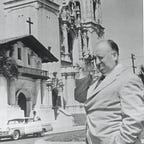Unit 3- An Aesthetic Liturgical Theology
Aesthetics is the appreciation of beauty. In spirituality, beauty is beyond what is pleasurable to the eye drawing us to a deeper sense of the divine. In reading Romano Guardini’s “The Spirit of the Liturgy”, one is able to grasp truly why the liturgy is the source and summit of our faith, and, therefore, truly aesthetic. Guardini dwells on specific concepts of the liturgy and in this week’s blog, I wish to explore three dimensions Fellowship, Symbolism, Playfulness and how they all connect us to the aesthetic realization that draws us to Christ.
Fellowship according to Guardini is that the liturgy is not the “I” but the “We”. When individuals gather for liturgy, the focus is on the greater community, those present and those beyond including the saints that have gone before. We together become the whole church. He quotes that “the faithful are actively united by a vital and fundamental principle common to them all. That principle is Christ Himself; His life is ours; we are incorporated in Him; we are His Body, Corpus Christi mysticum (pg.37)”. The liturgy is not focusing on what I may want as an individual, but what we as the church are being drawn together into Christ’s Paschal Mystery. Guardini mentions this spirit of oneness, a social solidarity. For example in the Prayers of the Faithful we don’t pray for our own personal needs but the needs of the entire Church. Our responses are communal as we repeat “we pray.” Guardini also says that we must accept letting go of our own expectations giving to the needs of the community. He quotes that “ he must lay self aside, and live with, and for others, sacrificing for the community a proportion of his self-sufficiency and independence(pg.38)”. The point of our sacrifice is to grow; Guardini refers to this as production, but not necessarily seen as a physical product for he says that we “must produce …acceptance and assimilation of a more comprehensive scheme of life than his own-that of the community (pg.38)”. There is always a tight balance of “I and We”, but the purpose of this production is to develop humility and faith that connects us to Christ.
The liturgy uses symbolism to connect with Christ on two levels in body and soul. Guardini states that God is a Spirit and the body is the emblem of the soul. Symbols like incense, candles and ritual actions, draw us, both body and soul deeper into the mystery. It is “like works of art, it must rise above the purely individual plane. It must not merely express isolated spiritual elements, but deal with life and the soul in the abstract (pg.57)”. He believes that “the people who really live by the liturgy will come to learn that bodily movements, the actions and the material objects which it employs are all the highest significance (pg.60)” Personally I feel that the Easter Vigil is a great display of the symbolism that Guardini mentions, with the darkness to the light, the fire, the ringing of the bells, the incense and the exultant which always moves me to the reality of the Risen Christ.
It was interesting to learn that the liturgy evokes a sense of playfulness. I had always understood that the liturgy was serious and reading further I came to understand what this playfulness was. Guardini states that “when the liturgy is rightly regarded, it cannot be said to have a purpose, because it does not exist for the sake of humanity, but for the sake of God. (pg.66)”. When we participate in the liturgy we are participating in the paschal mystery which is beyond our human capacity; it should be a body and soul experience. He mentions that, “the liturgy offers something higher. In it man, with the aid of grace, is given the opportunity of realizing his fundamental essence, of really becoming that which according to his divine destiny he should be and longs to be, a child of God (pg.69).” The liturgy draws out emotions, a sense of openness and a return to innocence like that of a child. Nothing should be expected in the liturgy but a way to connect with Christ. Gurardini states that, “the practice of the liturgy means that by the help of grace, under the guidance of the Church, we grow into living works of art before God, with no other aim or purpose than that of living and existing in His sight; it means fulfilling God’s Word and becoming as little children(pg.71)”. In participating in the liturgy just as a child we are often left with a sense of wonder.
In conclusion, as we discovered through the three dimensions of Fellowship, Symbolism, Playfulness, Romano Guardini’s liturgical theology is aesthetic. We experience this beauty in the liturgy and participate in the Paschal Mystery and connect to the divine revelation, Jesus Christ.
